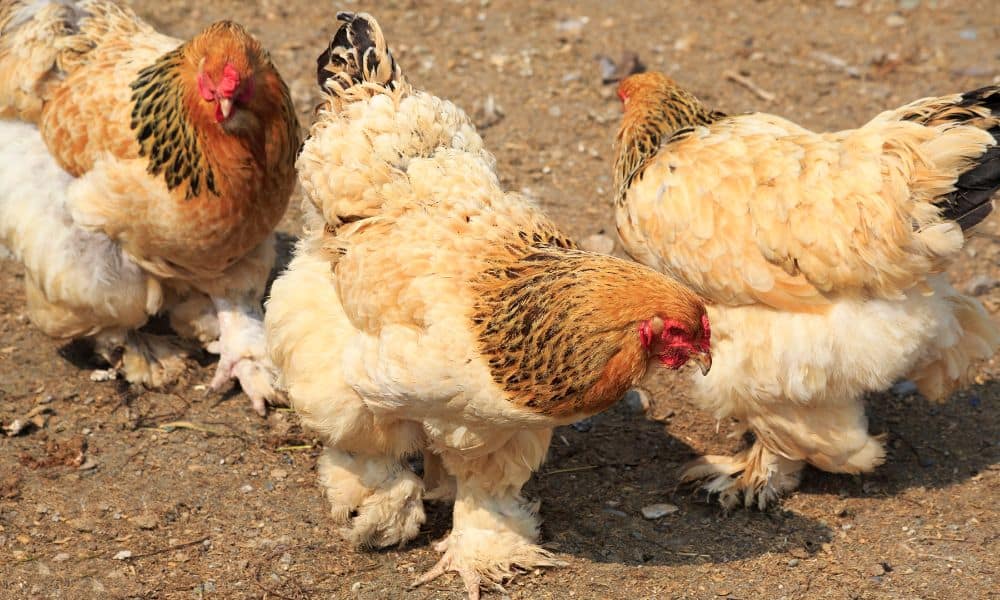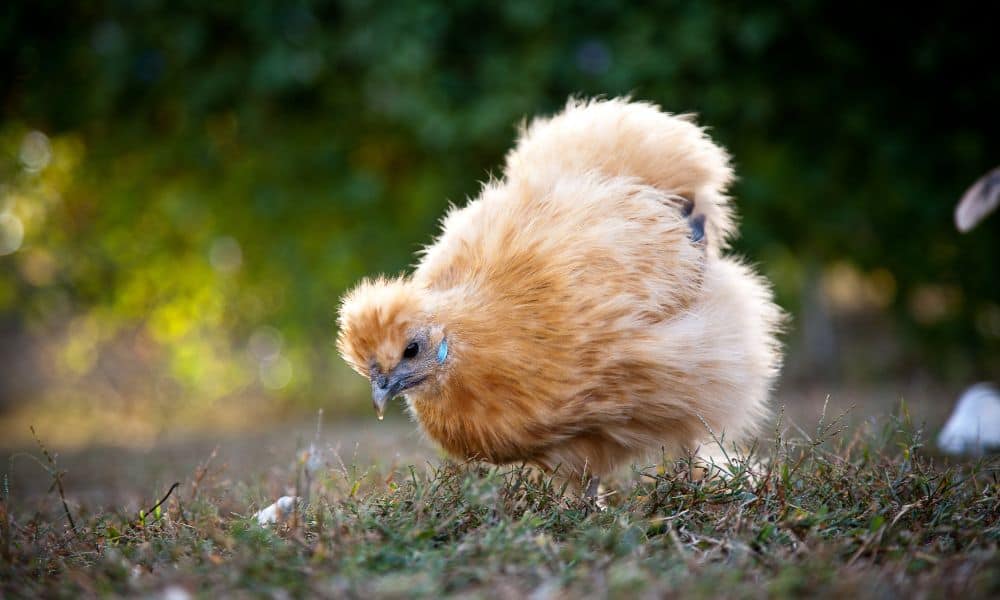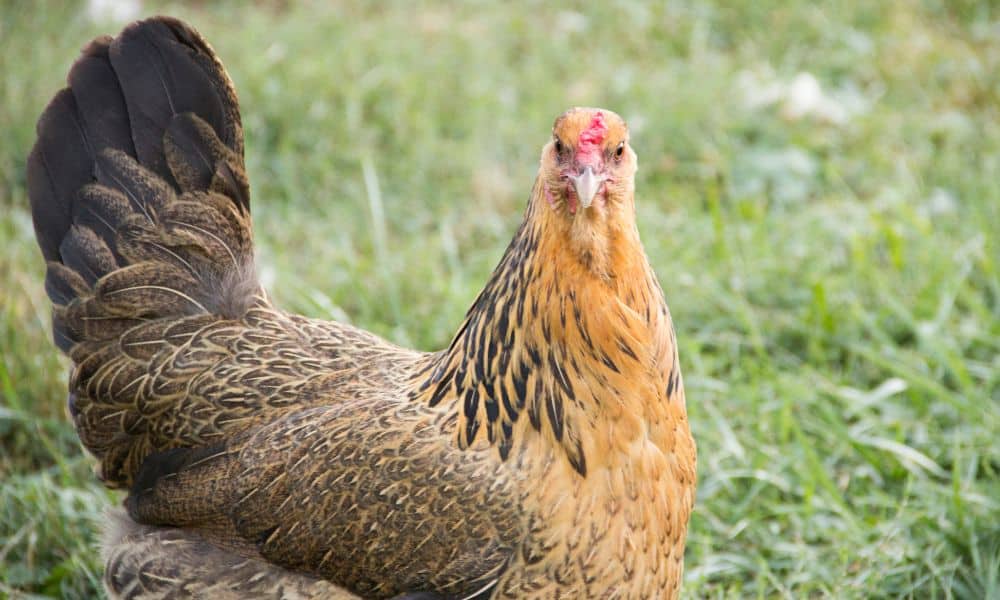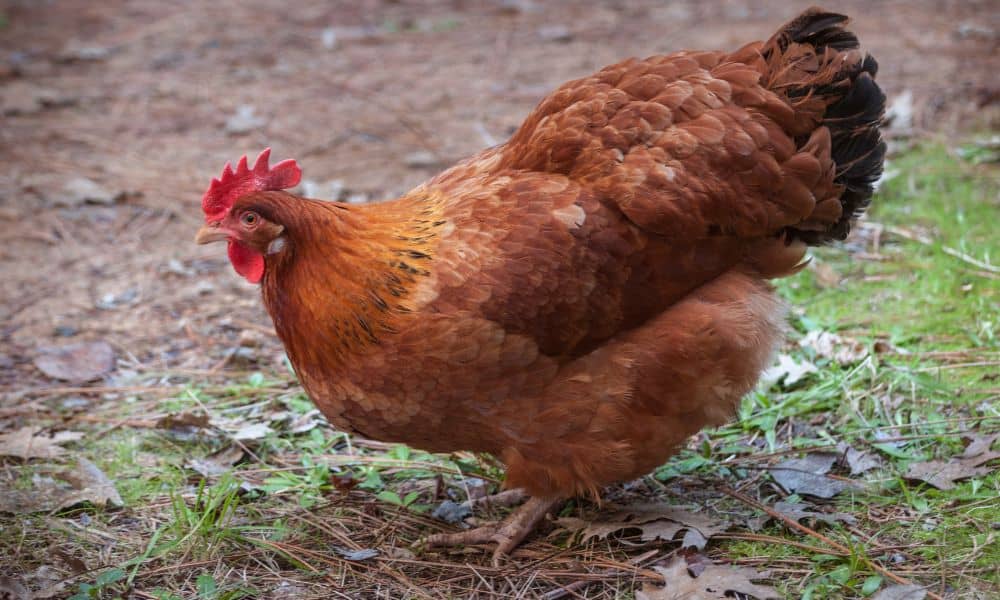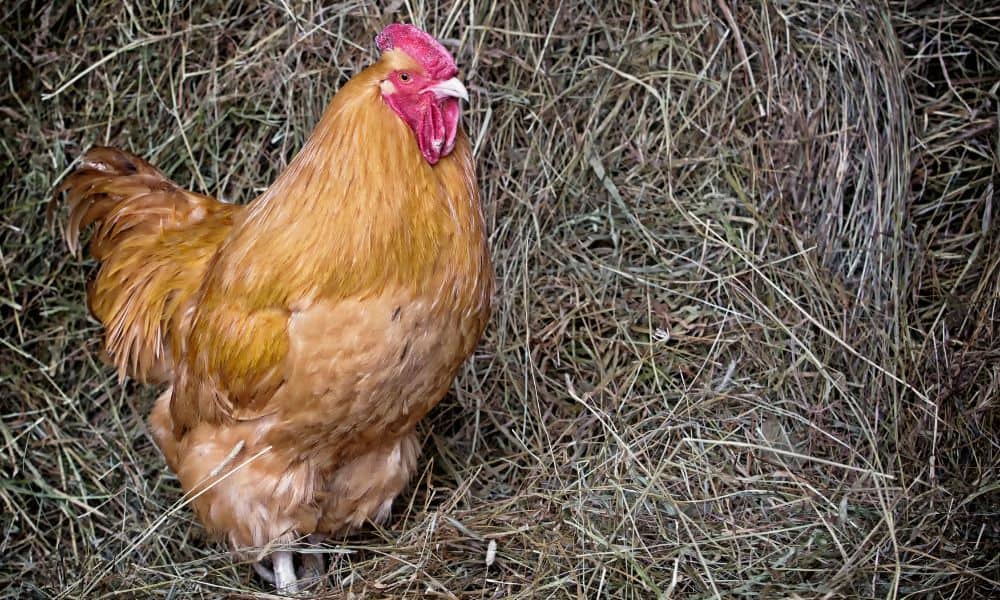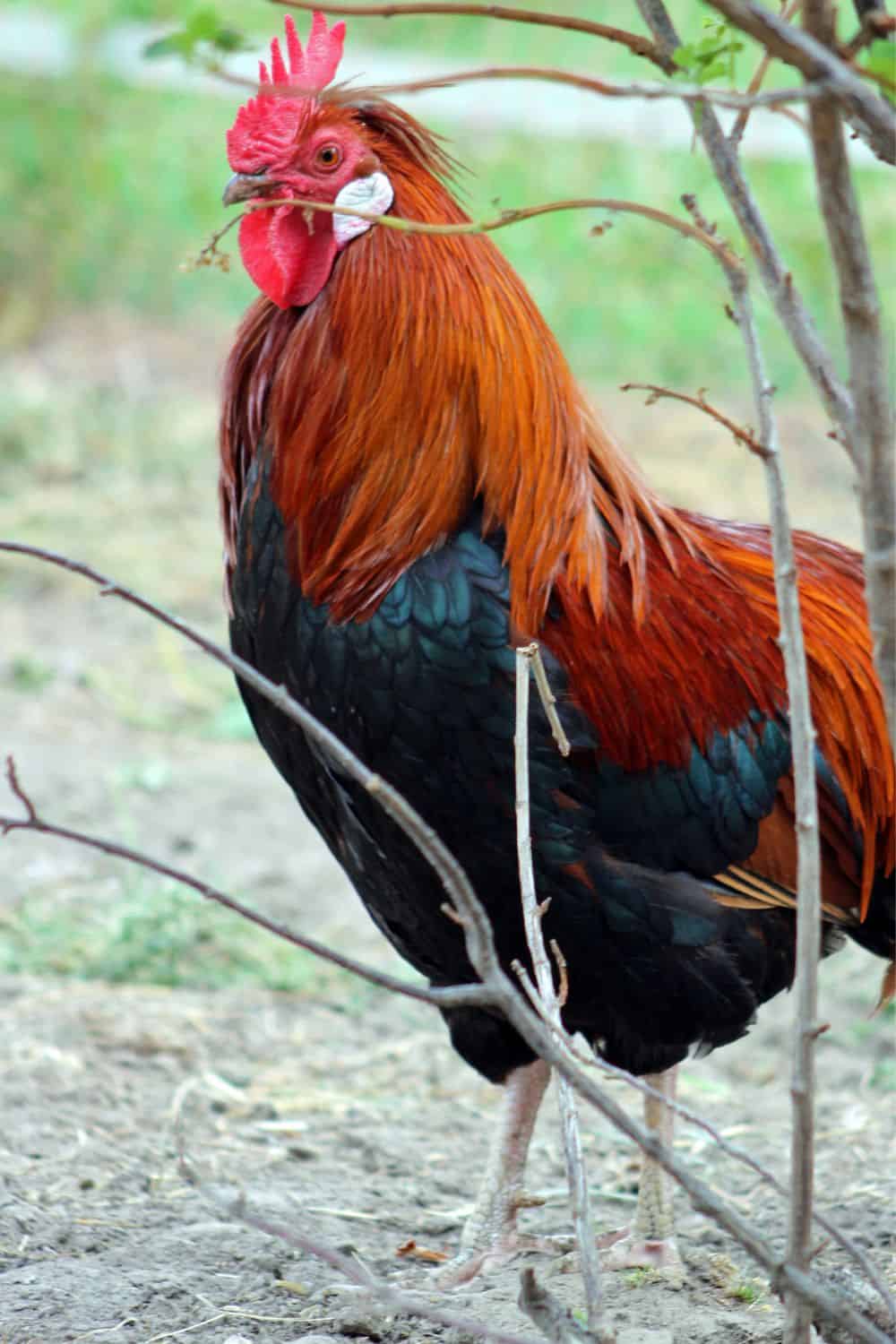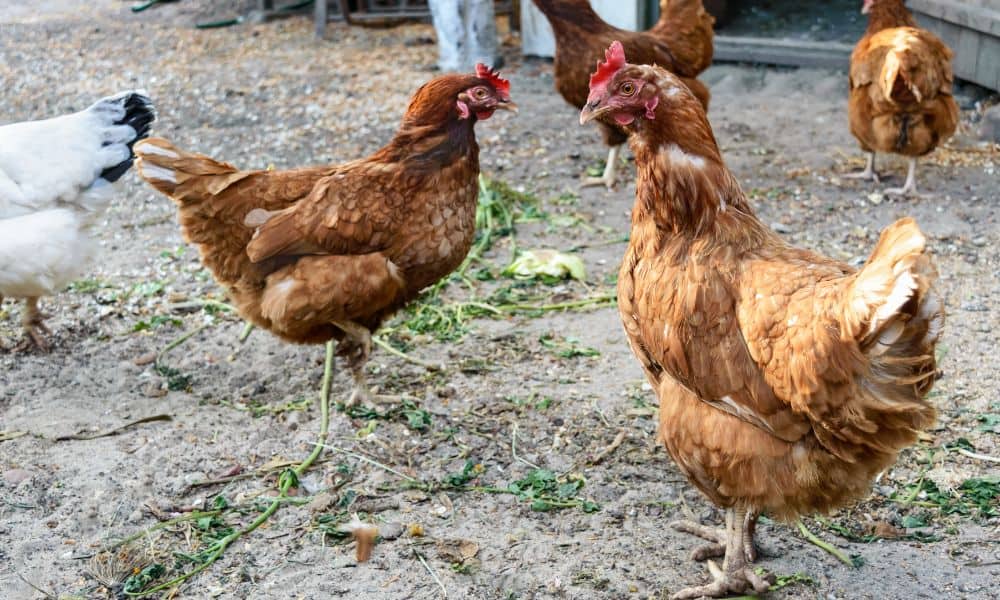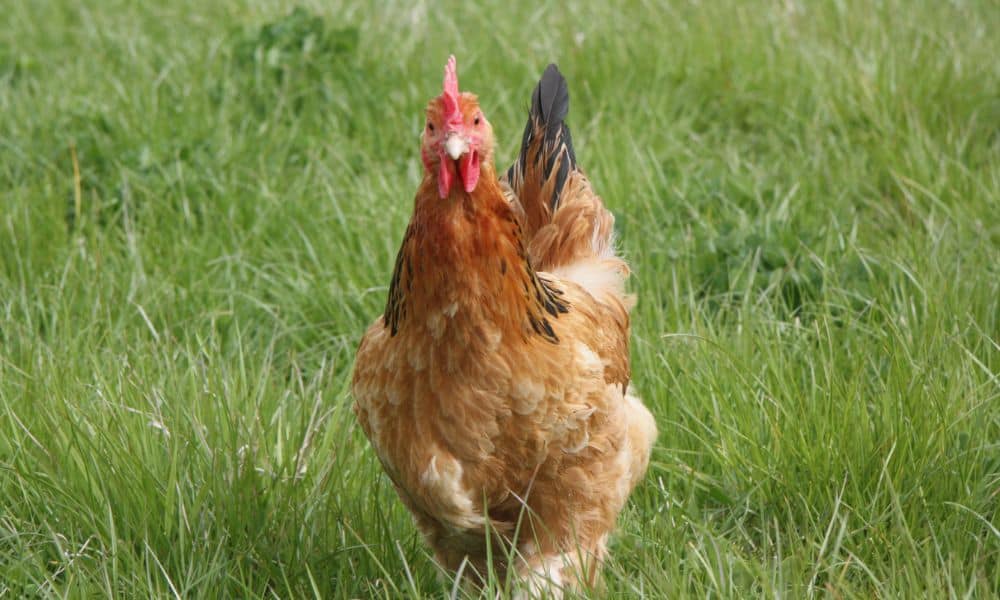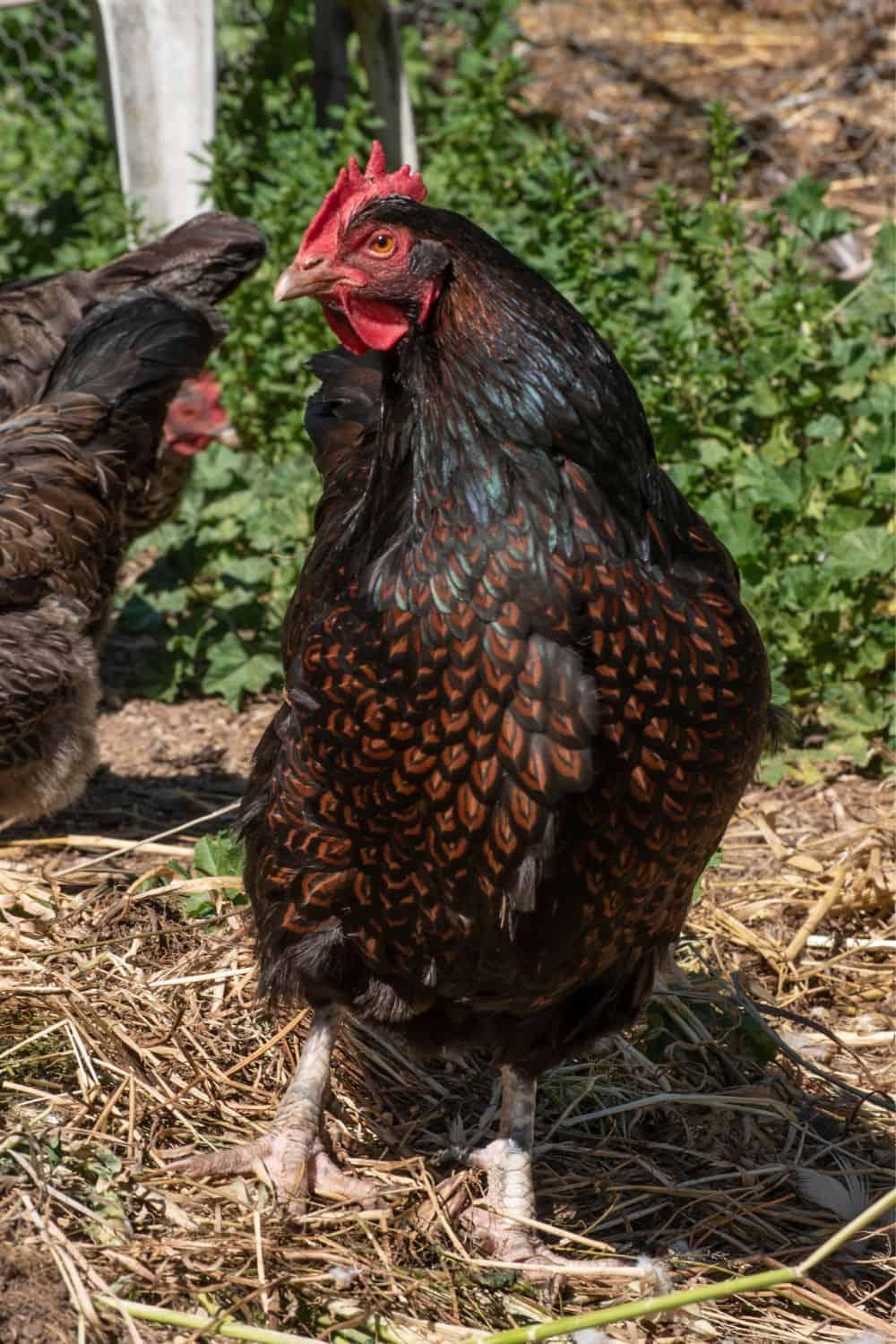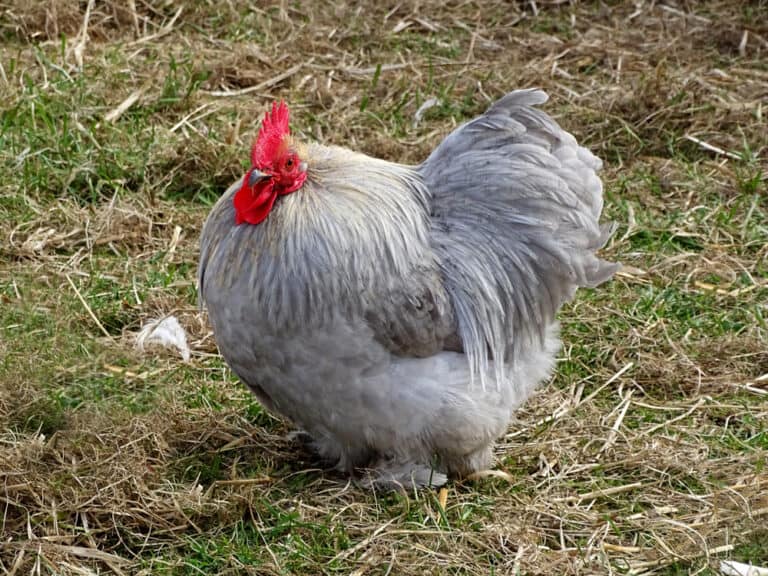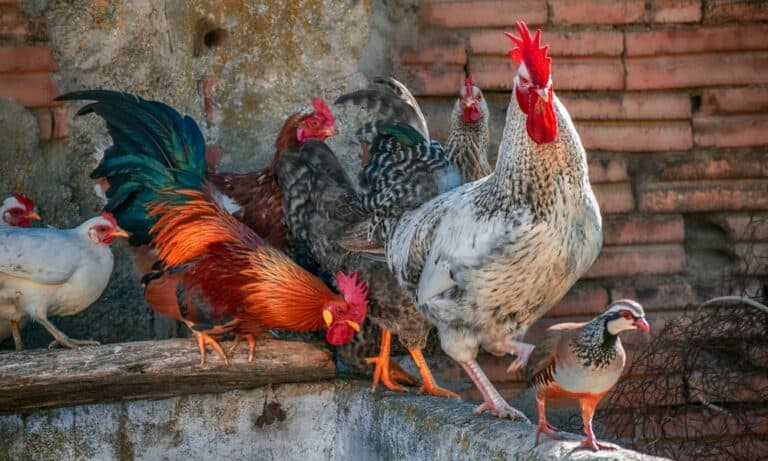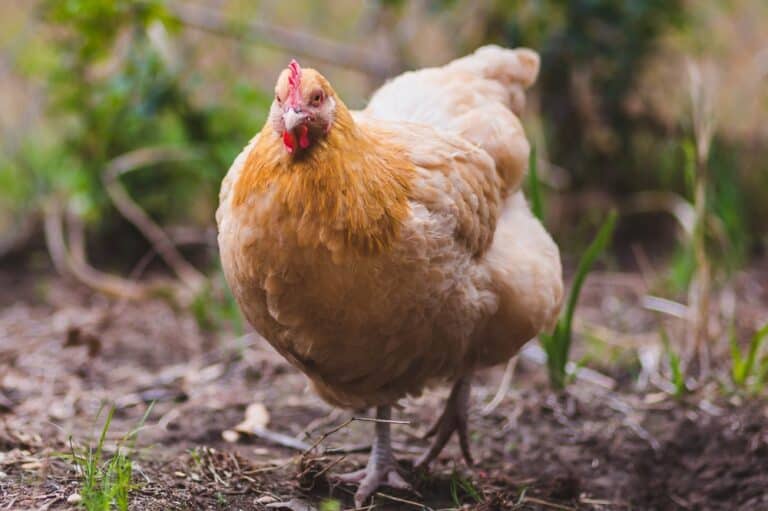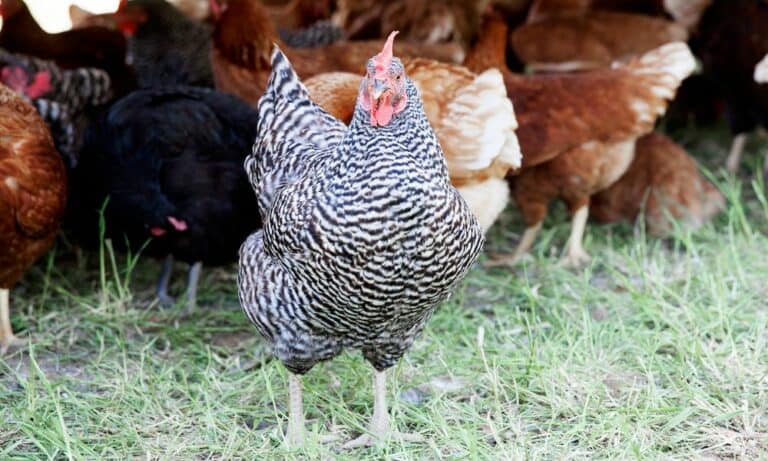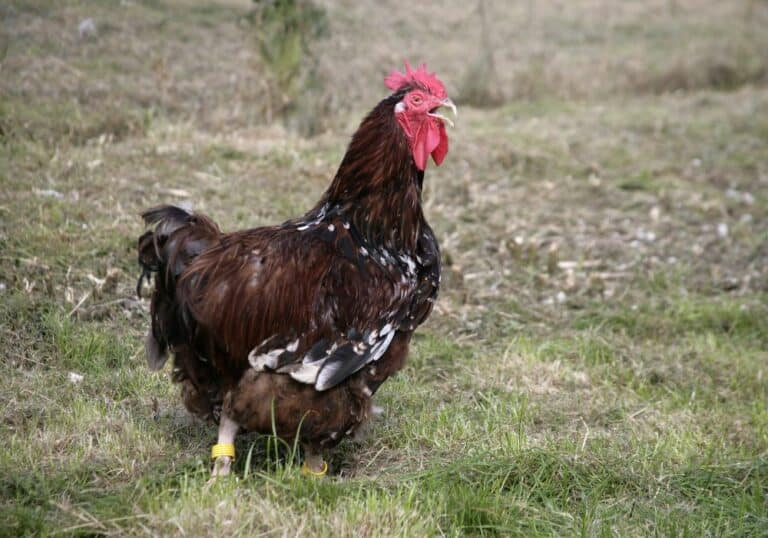Looking for a particular color fowl to grace your poultry yard? We’ve got you covered!
We’re focusing here on beautiful brown chicken breeds. And we’ve got 12 great options to share with you.
We’ll look at their characteristics and temperaments. And we’ll share some hints and tips for keeping them successfully along the way.
Ready to learn more? Let’s get started!
Top 12 Brown Chicken Breeds
1. Cochin
The Cochin comes in a wide range of different colors. But amongst those recognized by the American Poultry Association is brown.
It’s a large chicken that originated in China and was brought to the West in the nineteenth century. Its good looks helped promote interest in the new hobby of poultry fancying.
It’s notable for the heavy feathering on its legs and feet. That means that Cochins need to be looked after with care. If those feathers get wet or dirty, they can lead to infection – or in cold weather, to frostbite.
Standard males weigh between 8 and 13 pounds, while standard females are between 7 and 11 pounds. There’s also a bantam variety, with males weighing around 2 pounds, and females about 28 ounces.
Cochins are often kept as ornamental birds, but the hens are good layers too. Their eggs are large, and they’ll continue to lay through the winter. They’re good sitters and can also be used to incubate the eggs of other breeds. And when the chicks hatch, they make good moms too.
2. Silkie
Silkies get their name from their distinctive fluffy feathering, often likened to silk. There are a number of different color varieties, including buff – a golden shade. But you can also find chocolate Silkies, although the color isn’t yet recognized by the American Poultry Association.
Their unusual feathers have a different structure to those of most chickens. They’re more like fluffy down, and this means Silkies can’t fly.
They’re unusual in other ways too. Whatever the color of their feathers, all Silkies have black or blue-black skin and bones. Their earlobes are bright blue. And they have five toes on each foot, one more than most chooks.
They’re a small breed, with adult males weighing between 2 and 3 pounds. Adult females typically weigh between 1.5 and 2 pounds.
But despite their diminutive stature, Silkie hens are good layers and sitters, and will happily hatch the eggs of other birds.
3. Easter Egger
Strictly speaking, the Easter Egger isn’t actually a breed. It’s the name given to a particular kind of hybrid chook. Easter Eggers are bred from one bird with a blue-egg-laying gene and another with a brown-egg-laying gene.
As a result, the eggs of Easter Eggers can vary in color from bird to bird. But each hen will consistently lay eggs with the same color shell.
Only two breeds of chicken, the Araucana and the Ameraucana, lay blue-shelled eggs. But a huge number of different breeds lay eggs with brown shells. That means that there’s a broad and deep gene pool for Easter Eggers.
As a result, they’re generally healthy and robust chickens. And it also means that their feathers can be pretty much any color at all – including brown.
They often have muffs and beards, a pea-shaped comb, and greenish legs. And their wattles are either small or absent altogether.
4. Rhode Island Red
The Rhode Island Red is noted for its deep red plumage. But it’s actually a rich mahogany shade that’s a result of its heritage – Malay chickens with red feathers, and Brown Leghorns with brown.
Rhode Island Reds were originally used for both meat and eggs. Over the years, however, breeders concentrated on enhancing egg production.
As a result, they’re mostly kept today for their eggs. Traditional strains can lay between 200 and 300 per year. Modern chooks can lay even more.
They can have single or rose combs, and often have red on their toes and legs too. Their beaks are red-brown, and their combs, wattles and earlobes are all bright red.
Adult males weigh around 8.6 pounds, while females are a couple of pounds lighter. There’s also a bantam variety, with roosters weighing about 34 ounces and hens about 30 ounces.
They’re friendly, energetic and inquisitive birds. They’re usually fairly high up the pecking order, however, so it’s best not to mix them with more docile breeds.
5. Burford Brown
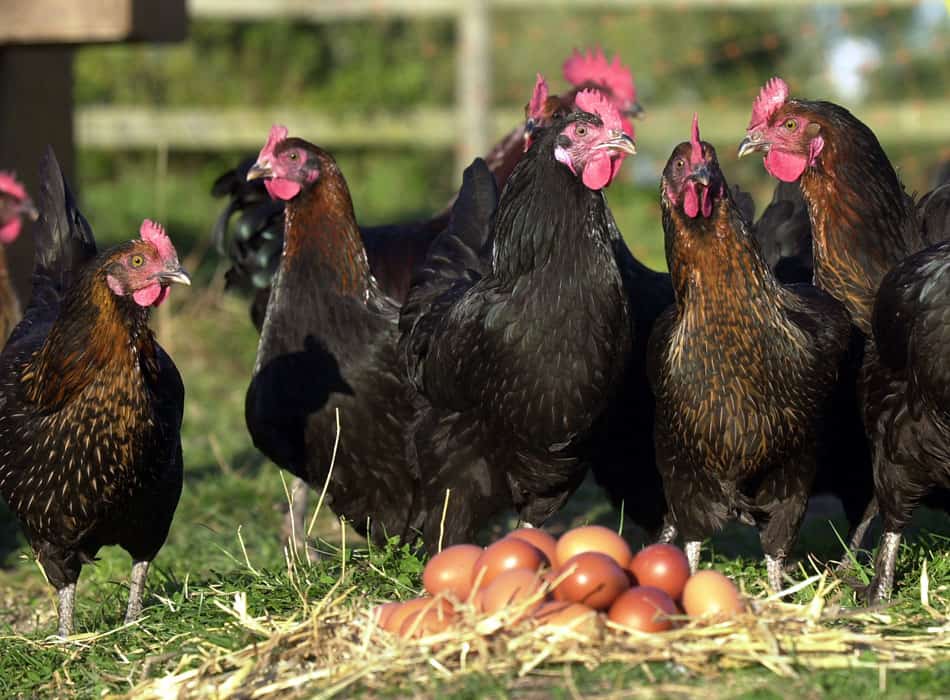
Burford Browns are known for producing exceptionally tasty brown eggs.
The breed was developed in the Cotswolds in England. From the outset, the focus was on egg production, with the eggs sold to upscale department store Fortnum and Mason. Today, the breed’s eggs are the choice of Britain’s top chefs.
Burford Browns have silky brown-black plumage that sits tight to their bodies. They’re good at coping with colder temperatures. And they’re gentle and friendly chickens. They interact happily with children and make great pets.
They do need plenty of space to roam, however. They’re active chooks and are happiest when exploring and foraging. They should ideally be kept free range. If confined to a run, they’ll need at least 10 square meters per bird.
Give them the space and care they need to flourish, and they’ll reward you with lots of delicious eggs. Hens will produce around 240 in their first year. And they’ll continue laying for many years.
6. Brown Leghorn
The Leghorn also goes by the name of the Livorno or Livornese. It originated in the Tuscan city of Livorno, and from there traveled to the US and Britain.
The most common variety is the White Leghorn. But there’s also a brown variety, with feathers that can be dark or light. Other colors include red, black-tailed red, Columbian and buff.
The hens are well known as excellent egg layers. They produce around 280 eggs a year, and can lay as many as 320. The eggs are a good size too, weighing around 2 ounces each. Leghorns aren’t good sitters, though, so if you want the eggs to hatch, you’ll need to invest in an incubator.
They’re intelligent, noisy birds, who love to roam and forage, and they’ll roost in trees if given the chance. As with many chickens bred for egg production, however, they can be rather nervous and flighty. And they’re not naturally good with children.
7. Orpington
The Orpington is a British breed that hails from a town of the same name in Kent, England. It can be found in a range of different color varieties, including the beautiful chocolate shade.
The first Orpingtons were bred for both their eggs and meat. These days, they’re used as show birds. They’re still good layers, though, with the hens able to produce anything from 150 to 250 medium-sized eggs per year.
They’re also one of the friendliest breeds around. They’re not just happy to interact with people, they actively enjoy attention and affection. They make great pets for kids, and will happily sit in your lap for cuddles.
There are standard and bantam varieties to choose from, with the former weighing anything from 6 to 10 pounds. Males tend to weigh about 2 pounds more than females. Bantams weigh between 3 and 3.5 pounds.
One thing to be aware of if you’re keeping Orpingtons is that they’re not particularly active. So it’s important to keep an eye on how much they’re eating to avoid them becoming overweight.
8. Altsteirer
The Altsteirer comes from Slovenia and the Austrian state of Styria. It’s also known as the Styrian Chicken. And amongst its three color varieties is an attractive red-brown shade.
There’s some variation amongst red-brown Alsteirers. Some have a partridge coloring, with a golden neck. And others have lighter red-brown plumage that’s darker over the neck.
They’re active birds, rather flighty, and tend not to enjoy being handled. They’re good fliers, and will be happiest roosting in trees.
They’re pretty hardy, but they have a single comb which can be vulnerable to frostbite. Rubbing it with some petroleum jelly in colder weather will prevent harm when your chooks are out and about.
The hens aren’t the most prolific of layers, laying between 130 and 160 eggs per year. Those that are allowed to roam free over a large area will produce the most eggs. And those eggs will be a good size, around 2 ounces, with ivory or cream colored shells.
9. Lohmann Brown
If you’re looking for a brown hen that’s a reliable egg layer, Lohmann Browns could be the perfect choice.
It’s a modern breed that’s the result of crossbreeding from Rhode Island Reds and White Rocks (white-feathered Plymouth Rocks). Their feathers are mainly shades of brown and caramel. They have a few white feathers around their necks and at the tips of their tails.
Lohmann Browns were developed specifically to maximize egg laying. Hens begin laying at 19 weeks of age, and can produce up to 320 eggs in their first year. The eggs get bigger as the hens mature, but average about 2.4 ounces. And the hens rarely get broody.
These chickens have a placid temperament, and even roosters are rarely aggressive.
Sadly for them, this breed is often used in industrial egg production. But give them a home in your yard, and you’ll be rewarded with happy, healthy chooks and lots of delicious eggs.
10. Sussex
The Sussex is a British breed originating from the English county of the same name. The Poultry Club of Great Britain recognizes eight different color varieties, including brown. Other shades include buff, red, white, speckled and silver.
There are both standard and bantam varieties. Minimum weights for standard Sussexes are 9 pounds for males and 7 pounds for females. The maximum weight for bantam roosters is 53 ounces, and for bantam hens it’s 39 ounces.
They’re a very appealing breed, gentle and calm yet curious and active too. They’re friendly to people (including children), happy to be handled, and love to chat! Even Sussex roosters are amiable fellows.
The hens produce plenty of eggs too. Expect between 200 and 250 brown or pink-tinted eggs per hen, per year. They’ll lay throughout the winter months, and they’re good sitters.
Sussex hens will happily incubate the eggs of other fowl. And their large size allows them to sit on clutches of up to 20 eggs at once. They’re good moms too, taking great care of the chicks when they hatch.
11. Buckeye
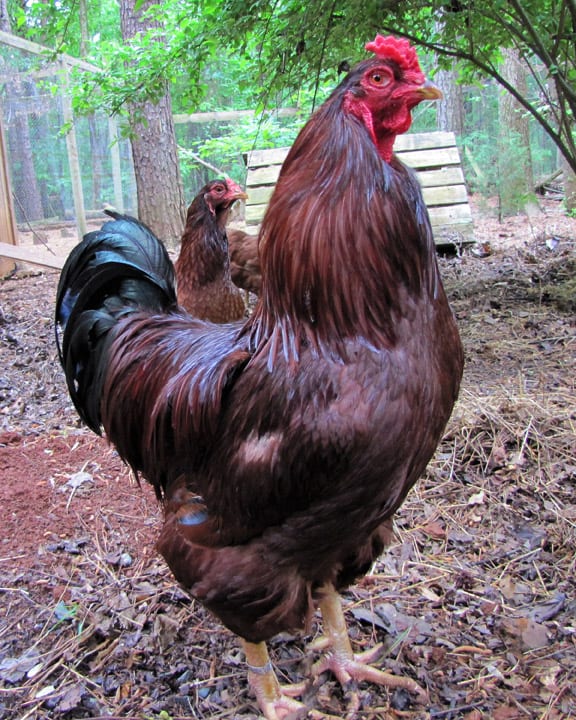
Buckeye chickens are American born and bred, created in the state of Ohio by an aviculturist called Nettie Metcalf. Their beautiful brown feathers are a key characteristic of the breed, developed to resemble the seeds of Ohio’s state plant, the Buckeye.
The tail feathers are black, and some roosters have other dark feathers too. These chickens are very similar in appearance to a Rhode Island Red, but Buckeyes have a slate-colored bar on the feathers near their bodies.
Other key characteristics include a stocky build and pea comb. It’s a combination that makes Buckeyes hardy birds, able to cope with colder temperatures. And the hens are decent layers, producing between 150 and 200 brown eggs per year.
Buckeyes are active and inquisitive chooks who’ll do best when left to roam free. They’re assertive chickens, and cocks can occasionally be aggressive, especially in the mating season.
12. Barnevelder
The Barnevelder is a Dutch breed that was developed around the middle of the nineteenth century. There are a number of different color varieties, including the beautiful double-laced brown Barnevelder.
Barnevelders have horn-colored beaks, yellow legs, and red combs, wattles and earlobes. Their eyes are red bay, and they have rectangular bodies, perky tails, and a single comb with five points.
Hens weigh between 5 and 6 pounds, while roosters are between 7 and 8 pounds. And there’s also a bantam strain, although that’s not currently recognized by the American Poultry Association.
The hens lay beautiful dark brown eggs that occasionally have speckles. They’ll typically produce 3 to 4 eggs a week, including through the winter months.
They’re calm and amiable birds, who like to chat with their keepers. They’re not too noisy though. And they’re good with children.
They’re happiest when able to roam free, and they’re excellent foragers. Their heavy feathering means they don’t enjoy heat or humidity. As with all breeds, make sure they have access to shade and plenty of cool, fresh water on demand.
Beautiful Brown Birds
That brings us to the end of our look at 12 brown chicken breeds. We hope you’ve enjoyed learning more about these beautiful chooks.
The breeds here range from ornamental birds to top-notch egg layers. And with colors ranging from rich mahogany reds to deep chocolate browns, there’s nothing boring about brown!

